QBARS - v35n4 The Madenii Series and Subseries
The Maddenii Series And Subseries
Arthur W. Headlam, Bentleigh, Australia
All Photos by Author
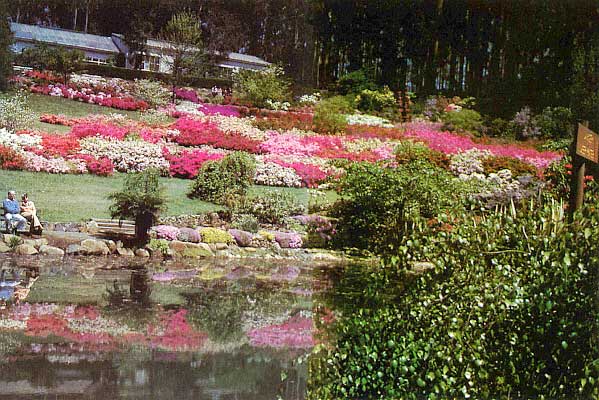
|
| National Rhododendron Garden at Olinda. "Kurume Bowl" |
The purpose of this paper is to describe some of the species in the Maddenii Series and Subseries growing in the National Rhododendron Garden at Olinda, Australia, where the climate is almost ideal for the growing of rhododendrons and their allied species, the altitude of some 2,000 feet, the rich acid volcanic moisture retentive soil combined with a rainfall of 50-60 inches per annum, of which a good percentage falls in the summer months.
Occasional falls of snow in winter rarely last more than a day and frosts on few occasions are severe enough to cause any appreciable damage. Factors which contribute to the ideal conditions are stands of mountain ash ( Eucalyptus regnans ), which grow to a height of 150 to 200 feet before they branch out, other eucalypts with crowns at lower levels which help to break the fall of rain and hail and reduce the force of the wind, whilst at lower levels again are blackwoods ( Acacia melanoxylon ), and other members of the Acacia family, as well as many other native trees and shrubs, and along the gullies and streams are tree ferns Dicksonia antarctica and Cyathea australis , with their long green spreading fronds, all helping to form a thick layer of humus on the forest floor. In winter, clouds often envelop the mountain and mists also help to create humid conditions in summer months.
The Australian Rhododendron Society was formed in 1958 by a group of enthusiasts, and the first show was held in a small hall in a recreation reserve at Olinda in 1960. The show was such a success that the Society decided a National Rhododendron Garden would be an acquisition, both to the Society and the State of Victoria, and after lengthy negotiations with the Government, a permissive occupancy lease of one hundred acres of forest land was approved, with a proviso that it was to be maintained by the Society without cost to the State, a quite formidable undertaking, and development of the first fifty acres commenced in 1961.
It was realized from the outset that the formation and maintenance of the garden would tax the resources of the Society to the utmost; however, it has been the dedication of members, past and present, the generosity of members and nurserymen in donating plants and money, and ultimately, welcome financial assistance from the Government and Tourist Development Association, which has finally brought about the realization of the original concept.
Members formed groups and worked in the garden at week ends and gradually the garden began to show progress. It was fortunate that members were aware that the climate was favorable for rhododendrons in the Maddenii Series and Subseries, and a group of R. nuttallii was planted on a slope just inside the entrance gate, which made an impressive sight with their large flowers, up to six inches across by five inches long, clear light yellow or white flushed yellow within, highly perfumed and attractively set off against a background of large and handsome strongly veined foliage.
These species are of particular interest to visitors from overseas, where, because of their cold tenderness, they are usually confined to greenhouse cultivation, with few exceptions such as the west coast of Scotland, some sheltered gardens in Cornwall and in the San Francisco Bay area. An outstanding color plate by Dr. John P. Evans, of R. nuttallii in his garden in the Bay area, appears on the cover of the A.R.S. Quart. Bull. , Vol. 35 No. 1.
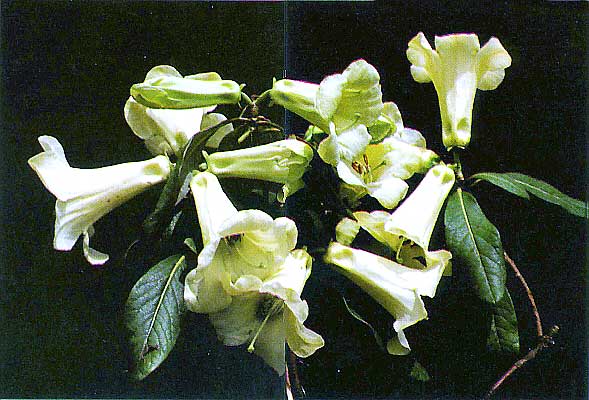
|
| R. dalhousiae |
Nearby, on the opposite side of the path to R. nuttallii , is a group of R. dalhousiae , whose habit of growth is admittedly inclined to be somewhat straggly, but this misdemeanor is quickly forgiven when it produces its clusters of white, white flushed pink, pale yellow and lemon yellow flowers in November. A native of Sikkim and Bhutan, 6,000-8,000 feet, R. dalhousiae was discovered by Hooker and named after Lady Dalhousie, wife of the Governor of India.
Following the path along the boundary fence, one comes to a dense thicket of R. johnstoneanum with flowers from white, white tinged pink and pale yellow, to a form with a fairly deep yellow flower. ( ARS Quart. Bull. , Vol. 34 No. 1, Illustrated in B & W).
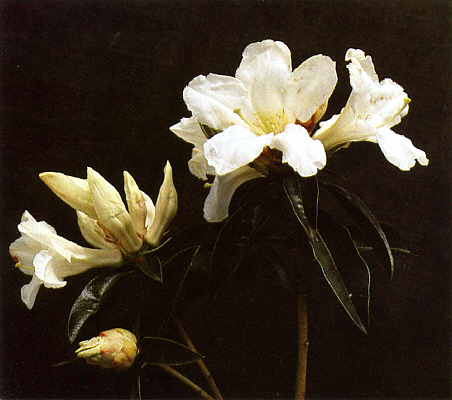
|
| R. maddenii |
In this area and in many positions around the garden are to be seen plants of R. maddenii , which attract attention for their fleshy white tubular flowers with a flush of rose on the outside, and for their perfume.
Along the slopes may be seen plants of R. polyandrum , burmanicum , crassum , lindleyi and ciliicalyx , the latter attracting attention with its smooth reddish-purple bark, its dense green glossy foliage and its flowers in clusters from seven to ten, funnel shaped, white or suffused with pale rose, especially noticeable when freshly opened, and also, as with others in this area, sweetly perfumed.
The Society holds two main shows each year, the early show over the first week end in October, and the main show in early November at the peak of the flowering season. Some thousands of people visit the garden during the spring and at the shows, but because of the late flowering characteristics of the Maddeniis, from about mid-November to the end of December, they are missed by all but the enthusiasts who come to the garden especially to see their fine display.
The development of the second fifty acres of the garden was commenced in 1975, with further welcome financial assistance from the Government as well as assistance from other horticultural societies, the Australian Lilium Society, the Alpine Society, Victoria, and the Australian Camellia Research Society, who all regularly stage exhibits in the show hall, thereby attracting many more visitors to the garden.
The Australia Camellia Research Society, Victoria Branch, has joined with the Australian Rhododendron Society in the development of the final fifty acres by establishing a camellia garden in an area allocated for this purpose.
A substantial section of the new area has been reserved for a rhododendron species garden in which some 750 species have already been planted, a considerable percentage being donated by members and nurserymen.
The species in the Maddenii Series and Subseries previously described in the vicinity of the entrance gate are certainly an inducement to members and visitors to follow the path which leads through the garden to the new species area, passing through the developing camellia garden en route, where from the top of the ridge there are magnificent views of the Yarra Valley with an impressive background of the Warburton Ranges rising to a height of 4,000 feet.
To digress, one could not help but comment on the division between the camellia and species gardens, a line following a ridge of forty five plants of R. arboreum , most of which are seven to eight feet high and some twenty eight years old, whilst those which have flowered to date have all been in the deep red colorings. These plants were raised by a member for whom the seed was specially collected in Nepal, but when he left Olinda, his property was sold. It was through the generosity of Peter Damman, Chairman of the Species Study Group, that this fine collection was secured for the National Rhododendron Garden, and mainly through his own strenuous efforts that they were lifted, transported and re-planted in the species garden.
However, to get back to the subject under review, all of the species previously described in the area in the vicinity of the entrance gate, as well as a comprehensive collection of species in the Maddenii Series and Subseries, have been planted in the new area, generally in groups of three as an insurance against loss or damage.
Stands of eucalypts and other native trees have been left to provide some protection against strong winds and hot afternoon sun in summer months. A study of the Rhododendron Species Handbook and other publications on this section of the genus indicate that they mainly carry flowers of white, white flushed pink or green, or flowers in the paler colors, and most are described as having flaking bark and a somewhat straggly habit of growth. For these reasons, some of the most outstanding, and some which differ from the general descriptions previously mentioned will be described.
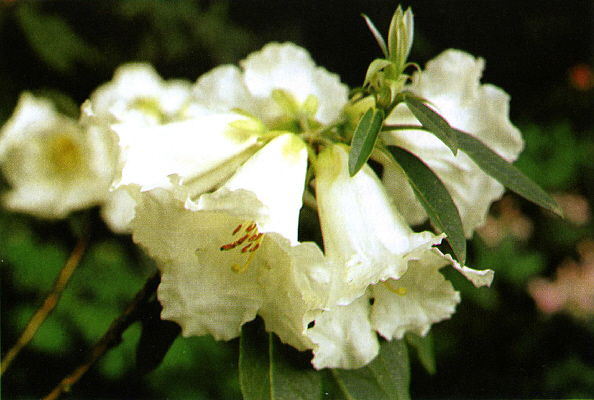
|
| R. lindleyi |
R. nuttallii again stands out and is a focal point of interest, whilst R. veitchianum carrying glistening white flowers slightly tinged with green, with deeply cut lobes and somewhat crinkled petal margins is closely challenged for pride of place by R. lindleyi , about which many eulogistic descriptions have been written, for its large tubular funnel shaped flowers, white or cream in color, whose pendent habit is reminiscent of a graceful lily, then follow two species whose growth habit is the exception to the rule, R. ciliatum , a spreading trailing shrub with rather small flowers, up to two inches long by two inches wide with nodding white or pink tinged flowers, and R. valentinianum , a small shrub of two or three feet, carrying clusters of bright butter cup yellow flowers, pubescent and scaly outside.
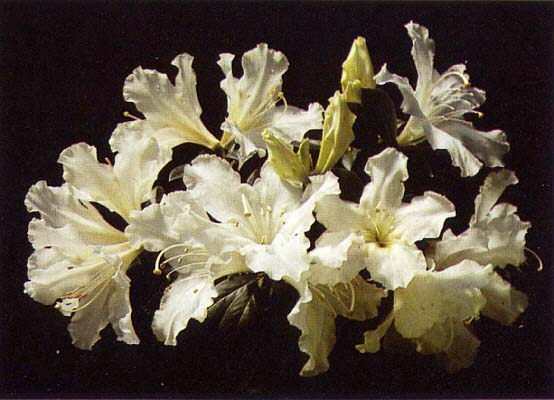
|
| R. veitchianum |
Following the track along the edge of the timber line, one comes upon several plants of R. megacalyx with their fragrant white flowers in trusses of three to five, broadly funnel shaped with the two lower petals usually larger than the others. The calyx, up to one inch long, has broadly ovate lobes, green or tinged with pink, a most attractive rhododendron from N.E. Upper Burma, 7,000-9,000 feet.
Then follow two species not so often seen in cultivation, R. parryae , a somewhat straggling shrub with smooth pinkish to purple bark, with leaves dark green above, glaucous green and scaly below. Flowers are carried in a lax truss of up to four, white with a yellow-orange blotch. R. parryae was raised from material obtained from the Royal Botanic Garden, Edinburgh.
R. calophytum , carrying flowers in trusses of up to four, widely tubular, with a faint rose blush on the outside, very similar in appearance to R. maddenii, was raised from material received from Dr. Heft of the Botanic Garden, Bremen.
Material from the last two named species was grown on to flowering size by Brian Clancy, when they were photographed and cuttings were propagated and the original plants and the struck cuttings were handed to the Society for eventual planting in the new species area.
There are groups of R. manipurense with shiny dark green foliage, densely scaly below, forming a fairly compact plant carrying pure white flowers in trusses of from four to six, tubular funnel shaped and fragrant, from Assam, Burma/Tibet border, 7,000-10,000 feet, and R. taggianum with large white flowers, fragrant, with a pale yellow basal blotch and reflexed lobes.
In an endeavor to conclude with something different, I have chosen R. rhabdotum , a somewhat straggling shrub with flowers 4-6 per truss, widely funnel shaped, creamy white suffused with yellow within and strikingly marked externally with five red stripe. S.E. Tibet, Bhutan and Assam, 5,000-8,500 feet. It is generally considered to be too tender for outdoor cultivation in most gardens.
It is quite a difficult task to describe members of this group with so many similar characteristics and colorings, no doubt the best way to become familiar with their idiosyncrasies would be for residents of Melbourne and Olinda to participate in the regular species group meetings, but even in the Group there are often debates as to the authenticity of certain species. The Species Handbook and other references are often produced but without avail. One can only refer members who are not satisfied with the labeling of the species in question, to the foreword in The Rhododendron Species Handbook 1963: "The genus Rhododendron in its many species covers an enormously wide range. In addition, almost without exception, each species of rhododendron can vary greatly from one plant to another in colour, in shape and size of bloom, in foliage, in habit, and in other characteristics. This is well illustrated, especially as to blooms, at the Rhododendron Show. Such variations have recently been recognized to be almost as pronounced within most of the species as they are in the case of hybrids. This variability is one of the great charms of rhododendrons, but it does complicate the task of identifying the different species and of appraising and acknowledging their qualities".
Despite some variations within the species, which are not confined to this particular section of the genus, rhododendrons in the Maddenii Series and Subseries are a valuable acquisition in any collection, even when frosts and extreme of cold force them into a greenhouse for satisfactory results, they are still considered by many growers to be well worth the extra trouble involved; however, in these circumstances the range must be much more selective as it would take a huge greenhouse complex to house the many species growing in the National Rhododendron Garden at Olinda.
